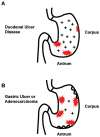Helicobacter pylori's unconventional role in health and disease
- PMID: 19855816
- PMCID: PMC2729406
- DOI: 10.1371/journal.ppat.1000544
Helicobacter pylori's unconventional role in health and disease
Abstract
The discovery of a bacterium, Helicobacter pylori, that is resident in the human stomach and causes chronic disease (peptic ulcer and gastric cancer) was radical on many levels. Whereas the mouth and the colon were both known to host a large number of microorganisms, collectively referred to as the microbiome, the stomach was thought to be a virtual Sahara desert for microbes because of its high acidity. We now know that H. pylori is one of many species of bacteria that live in the stomach, although H. pylori seems to dominate this community. H. pylori does not behave as a classical bacterial pathogen: disease is not solely mediated by production of toxins, although certain H. pylori genes, including those that encode exotoxins, increase the risk of disease development. Instead, disease seems to result from a complex interaction between the bacterium, the host, and the environment. Furthermore, H. pylori was the first bacterium observed to behave as a carcinogen. The innate and adaptive immune defenses of the host, combined with factors in the environment of the stomach, apparently drive a continuously high rate of genomic variation in H. pylori. Studies of this genetic diversity in strains isolated from various locations across the globe show that H. pylori has coevolved with humans throughout our history. This long association has given rise not only to disease, but also to possible protective effects, particularly with respect to diseases of the esophagus. Given this complex relationship with human health, eradication of H. pylori in nonsymptomatic individuals may not be the best course of action. The story of H. pylori teaches us to look more deeply at our resident microbiome and the complexity of its interactions, both in this complex population and within our own tissues, to gain a better understanding of health and disease.
Conflict of interest statement
The authors have declared that no competing interests exist.
Figures


References
-
- Marshall BJ, Warren JR. Unidentified curved bacilli in the stomach of patients with gastritis and peptic ulceration. Lancet. 1984;1:1311–1315. - PubMed
-
- Nomura A, Stemmermann GN, Chyou P, Kato I, Perez-Perez G, et al. Helicobacter pylori infection and gastric carcinoma among japanese americans in Hawaii. N Engl J Med. 1991;325:1132–1136. - PubMed
-
- Parsonnet J, Friedman GD, Vandersteen DP, Chang Y, Vogelman JH, et al. Helicobacter pylori infection and the risk of gastric carcinoma. N Engl J Med. 1991;325:1127–1131. - PubMed
-
- Parsonnet J, Hansen S, Rodriguez L, Gelb AB, Warnke RA, et al. Helicobacter pylori infection and gastric lymphoma. N Engl J Med. 1994;330:1267–1271. - PubMed
Publication types
MeSH terms
Grants and funding
LinkOut - more resources
Full Text Sources
Medical

